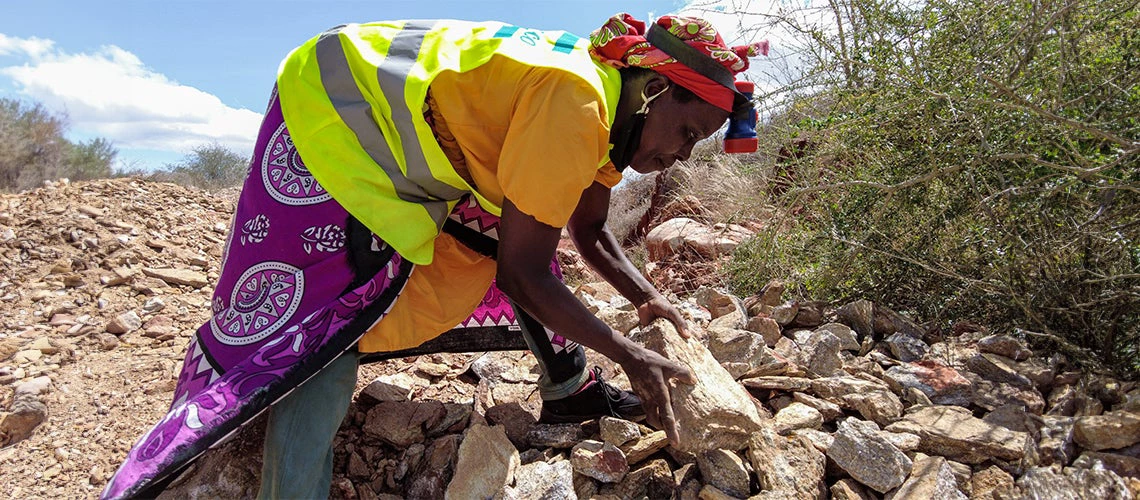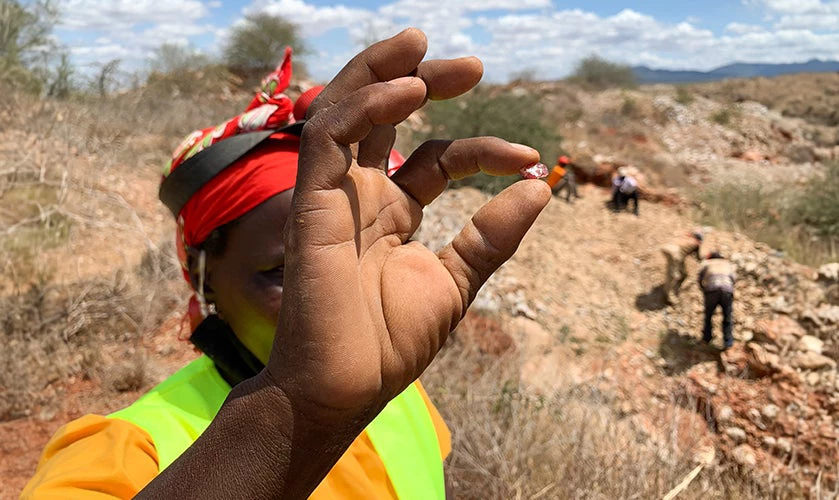 African woman artisanal miner at work.
African woman artisanal miner at work.
They help provide materials for global technology, but at the cost of their health and safety
In gold mining towns across Africa, women spend hours at the entrance of artisanal and small-scale mines as they sort and grind ore in search of precious metals. Often, they are exposed to polluted water and sometimes dangerous chemicals. At the end of an arduous day, they face additional domestic work in their homes, resulting in extreme fatigue and chronic pain.
"You arrive home too tired because the work is too heavy,” one woman in the Democratic Republic of Congo told a team of researchers in 2021. “You will even prepare the food and you will have no appetite. During the whole night, you will be remembering the ‘mutwangiyo’ (a stick used to pound rocks). This will disturb your sleep and affect your health.”
Artisanal and small-scale mining (ASM) significantly contributes to the supply of minerals essential for modern technologies, including communications and clean energy technologies, which are crucial for the global clean energy transition. The sector employs 45 million people globally and provides 233 million indirect jobs. Managed properly, ASM can positively contribute to the economy, boosting development and reducing poverty.
However, the informal, often precarious nature of their working conditions and lack of access to social safety nets expose ASM workforces to severe health, social, and environmental risks. Up to 90% of ASM miners worldwide operate without licenses and permits required by law. Efforts to improve the sector have yet to achieve a significant impact at scale, especially for women, who disproportionately bear the adverse effects of ASM activities and remain under-protected.
Women comprise 30% of the ASM workforce. But they are often barred from entering the mines and relegated to lower-paying difficult jobs. They face harassment, unsafe working conditions, a lack of sanitation facilities, and sometimes violence. Women in many communities face difficult choices. Their employment options within ASM are limited, yet it is often their only opportunity to make a living and support their children. Equality and empowerment of women and girls will not be possible until their rights are secured in legal frameworks.
Our new State of the Artisanal and Small-Scale Mining Sector report, launched at the 2024 Mining Indaba Conference, advocates for gender-focused legislation to improve mining codes to enhance women’s participation. It also urges change in discriminatory property laws and land tenure agreements that hinder women's ability to own land and access mineral resources. Three key recommendations require urgent attention:
- First, we need to make mining laws and economic policies gender inclusive. Our gender assessment of 21 legal frameworks across Asia, South America, and Africa shows that more than two-thirds of mining codes that regulate the management and production of minerals, and 80% of laws concerning property rights, don’t adequately support women’s access and control over resources. This is a problem that cannot be ignored: Women face numerous obstacles finding opportunities in the ASM sector, and gender-inclusive mining laws are fundamental to leveling the playing field. We must also improve land rights and tenure arrangements. Land ownership enables women to access capital and credit to grow their operations, buy equipment, invest in technology, and generate higher value from mining. The good news is that we are making progress. In a recent survey, 67% of government officials said they have undertaken programs that specifically empower women in ASM, and nearly all of them said they include women when developing initiatives to formalize the sector through permitting and regulation.
- Second, we must advance women's social protection in the mines and their homes. Our survey results indicate that the ASM sector has made some progress in implementing social protections for women on the job, but they still face multiple socio-economic challenges. Young girls encounter barriers to accessing education. In adolescence, many are forced to leave school early, and some are at risk of early pregnancies. Then, in adulthood, women face unequal treatment and unsafe working conditions. Governments and civil society organizations must partner to develop educational and livelihood training programs to help women obtain decent work and financial literacy programs to build their economic resilience and independence. One case study in the report demonstrates how education can improve women’s work in alluvial diamond mining of the Central African Republic through improved techniques. Interventions also helped women secure land rights to mined-out pits and convert them into gardens for food crops.
- Third, it is time to acknowledge the distinct occupational health and safety issues women face. The perception of the mining industry as male-dominated has led to widespread disregard for women’s health and safety, with more than one-third of miners surveyed reporting that environmental impacts on women in ASM have increased in recent years. Many women in ASM cannot afford personal protective equipment or improved mining technologies. In Rwanda, a government-led initiative has provided miners with headlamps, improving personal safety for women in the underground mines. In gold mining, women are often exposed to mercury, a potent neurotoxin that can be transferred to children through breastfeeding and cause miscarriages and preterm births. Yet, recent focus groups with women from Ghana’s gold mines revealed that none of them were aware of the dangers they faced. Women in ASM need comprehensive health support, including education and maternal care. It is also imperative we confront widespread gender-based violence in the ASM sector through awareness campaigns, education, and robust laws to safeguard the safety and well-being of women.

Small changes at the community level can significantly impact the lives of female miners and their families. In South Africa, a project has helped women working in diamond mines find alternate employment in the sector, such as jewelry making, evaluation, and trade. In Peru, women concession holders are adopting responsible mining practices, including pilot programs to use clean technologies and to help restore areas degraded by mining operations. In Ghana, a Girls for Mining club encourages students to take mining, technology, and engineering courses. The country’s Women in Mining Training Institute offers female workers programs in gender issues, justice, leadership, and the economics and business of mining. Women’s associations and professional groups have been essential to these and other efforts to improve women's visibility and advance mining reforms. These gender-focused groups must be further empowered and mainstreamed.
Equality and empowerment of women and girls will not be possible until their rights are secured in legal frameworks.
The obstacles confronting women artisanal and small-scale miners span legal, social, and economic domains, but change is within reach. In the last four decades, the World Bank has been a champion of formalizing the small-scale sector, with a specific focus on women miners. Through partnerships and action, we can improve the livelihoods and well-being of women in ASM and their communities. It's our collective duty to ensure that those at the frontlines of the economic energy nexus are also the ones to benefit.
Subscribe here to stay up to date with the latest Energy blogs.
Note: This post first appeared on Business Day.



Join the Conversation